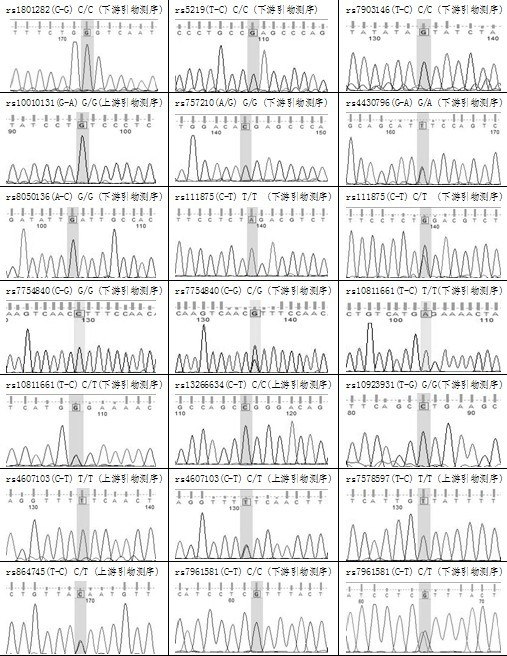Gene chip for detecting mutation of 18 loci of susceptibility genes of type 2 diabetes
A type 2 diabetes and gene chip technology, which is applied in the field of gene chips for rapid detection of mutations at multiple sites of type 2 diabetes susceptibility genes, can solve the problems of limited detection of gene sites, cumbersome operation, and high cost, and achieve consistent fluorescence intensity Good performance and simple operation
- Summary
- Abstract
- Description
- Claims
- Application Information
AI Technical Summary
Problems solved by technology
Method used
Image
Examples
Embodiment 1
[0050] Probe and Primer Design
[0051] The present invention screens type 2 diabetes susceptibility gene site mutations, designs related probes, and obtains a group of probes with high hybridization specificity and high accuracy after repeated tests, screening and verification. The probe sequences are shown in Table 1. Show.
[0052] Table 1 The wild-type and mutant probe sequences of 18 sites
[0053]
[0054]
[0055] When the probe is synthesized, 15 more poly-Ts are synthesized at the 5' end, and are modified by amino groups (using standard phosphoramidite chemical method, 5' or 3' amino modification with 5'-Amino-Modifier C6, TFA- protected is introduced in the last step after synthesis). The poly-T modified probe required for the chip (the probe was synthesized by InvitrogenG) was resuspended with TE Buffer (100mM Tris-Cl pH 8.0, 10mM EDTA pH 8.0) to a solution with a concentration of 50μM, and the concentration was 1:1 before sample application. The ratio was ...
Embodiment 2
[0061] Glass medium gene chip preparation
[0062] Aldehylation modification of the glass slide; resuspend the pre-synthesized probe (the probe was synthesized by InvitrogenG) with TEBuffer (100mM Tris-Cl pH 8.0, 10mM EDTA pH 8.0) to a solution with a concentration of 50uM, press 1 : 1 ratio mixed with spotting buffer (Micro Spotting Solution Plus 2X, Telechem), the final concentration is 25 μ M; figure 1 ) are arranged in a 96-well plate; PBS solution washes the spotting needle of the spotting instrument (SpotBot3, Telechem), calibrates, and presses figure 1 Matrix spotting; room temperature hydration fixation.
Embodiment 3
[0064] Detection methods of susceptibility loci
[0065] (1) Sample DNA extraction
[0066] Peripheral blood DNA was obtained, and genomic DNA was extracted using a blood genome DNA extraction kit (blood genome extraction kit DP318-02, TIANGEN) according to the manufacturer's instructions.
[0067] (2). Target DNA amplification, hybridization, detection:
[0068] The PCR reaction solution is composed of 10×buffer, 10μmol / L forward primer, 10μmol / L reverse primer, 25mmol / LMgCl 2 , 10mmol / L dNTPs (containing 0.5nM Cy3-dCTP, provided by Amersham Company) and sterile double distilled water. Amplification conditions are pre-denaturation at 95°C for 3 min, 35 cycles (denaturation at 94°C for 30 s, annealing at 55°C for 30 s, extension at 72°C for 30 s), extension at 72°C for 7 min; denaturation at 100°C, quenching; pre-hybridization at 42°C for 30 min to block non-specificity Binding; preheated denatured Cy3-DNA and hybridization solution (DIG Easy Hyb, Roche) were mixed at a rat...
PUM
 Login to View More
Login to View More Abstract
Description
Claims
Application Information
 Login to View More
Login to View More - R&D
- Intellectual Property
- Life Sciences
- Materials
- Tech Scout
- Unparalleled Data Quality
- Higher Quality Content
- 60% Fewer Hallucinations
Browse by: Latest US Patents, China's latest patents, Technical Efficacy Thesaurus, Application Domain, Technology Topic, Popular Technical Reports.
© 2025 PatSnap. All rights reserved.Legal|Privacy policy|Modern Slavery Act Transparency Statement|Sitemap|About US| Contact US: help@patsnap.com



